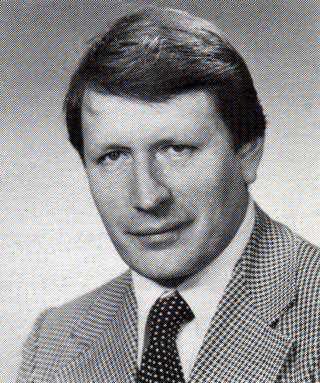
 |
Search | FAQ | US Titles | UK Titles | Memories | VaporWare | Digest | |||||||
| GuestBook | Classified | Chat | Products | Featured | Technical | Museum | ||||||||
| Downloads | Production | Fanfares | Music | Misc | Related | Contact | ||||||||
| Memories of VideoDisc - Who's Who in VideoDisc | ||||||||||||||

Walter Kosonocky was Fellow of Technical Staff, IC Technology Research, RCA Laboratories where he was on the team that developed the CCD Comb Filter Integrated Circuit. He shared a David Sarnoff Award for Outstanding Technical Achievement for this development in 1981. This IC was adapted to implement the buried subcarrier signal encoding in the RCA VideoDisc system.
Dr. Kosonocky has been involved with the research and development of CCD's for signal processing applications. This work has led to contributions in basic device performance limitations such as interference trapping, fringing field drift, free-charge transfer and device noise. In addition to his basic work on CCD's, he was the principal architect of the buried-channel, double-level polysilicate-gate NMOS CCD wafer fabrication process. This high-performance, state-of-the-art, n-channel process is essential for the production of CCD comb filter IC's.
A number of patented inventions made by Dr. Kosonocky alone and some made jointly with others, are incorporated in the comb filter. These include the so called "fill and spill" input circuit to the CCD, CCD structures for charge addition and subtraction, and others.
- 1981 David Sarnoff Award Announcement
Walter F. Kosonocky (M'65-SM'70-F'76) received the B.S. and M.S. degrees in electrical engineering in 1955 and 1957, respectively, from the Newark College of Engineering, Newark, NJ, and the Sc.D. degree in engineering in 1965 from Columbia University, NY. Since April 1987, he has been a Distinguished Professor in the Electrical Engineering Department and holder of the Chair in Optoelectronics and Solid-State Circuits at the New Jersey Institute of Technology, Newark, NJ. From 1955 through March 1987, he was employed at the David Sarnoff Research Center (formerly RCA Laboratories), Princeton, NJ. He became a Member of the Technical Staff in 1956, and was appointed Fellow of the Technical Staff in 1979. Since April 1987, he was associated with the David Sarnoff Research Center as a Consultant on Solid-State Image Sensors. At the David Sarnoff Research Center, he was engaged in research on solid-state devices, circuits, and systems applications. This work included: from 1955 to 1961, development of ferrite memories and investigations on parametric and tunnel diode digital circuits; from 1961 to 1970, applications of lasers as switching devices, optical hologram memories, and MOS sensor arrays; from 1970 to 1977, the development of charge-coupled devices for memories, signal processing, and image sensors; and since 1977, the development of processing and designs for infrared CCD imagers with platinum silicide Schottky-barrier photosensors. He was an author or co-author of 77 technical papers and was issued 47 U.S. patents.
Dr. Kosonocky shared four RCA Laboratories Outstanding Achievement Awards (in 1959, 1963, 1980, and 1984) and two David Sarnoff Awards for Outstanding Technical Achievement (in 1981 and 1984). In 1985, he received the IEEE J. J. Ebers Award for "pioneering and innovative contributions to the development of charge-coupled devices and Schottky-barrier infrared image sensors." He was a member of Tau Beta Pi, Etta Kappa Nu, Sigma Xi, SPIE, and SPSE. From 1973 to 1977, he was Chairman of the Solid-State Circuits Committee of the IEEE Circuits and Systems Society. From 1974 to 1978, he as Chairman of the Integrated Circuits Technology Committee of the IEEE Electron Devices Society. He served on the Technical Program Committees of the 1977 International Electron Devices Meeting, from 1976 to 1981, was the International Solid-State Circuits Conference, and was the Technical Program Chairman of the 1979 ISSCC. From 1979 to 1982, he was Chairman of the IEEE-EDS's VLSI Committee. From 1987 until November 1996, he was Editor of the Image Sensors and Displays area of the IEEE Transactions on Electron Devices. He was also the Guest Editor of Joint Special Issues of the Transactions on Electron Devices on VLSI Technology for April 1979, August 1980, and April 1982, and on Solid-State Image Sensors for August 1985. He was Chairman of the 1981 Symposium on VLSI Technology and, starting in 1985, was Chairman of the IEEE Executive Committee for this Symposium. He was the Technical Program Chairman of the 1984 Electronic Imaging Conference (EIC) and the Chairman of the 1985 EIC.
- 1997 IEEE Biography
It is with sadness that we acknowledge the passing of Professor Walter F. Kosonocky. His death last November at the age of 64 shocked and saddened his family, friends, and the professional community. Walter joined the editorial board of the TRANSACTIONS in 1987, taking charge of the Image Sensors and Displays area. For nine years, Walter brought all of his expertise to this position as Editor and diligently served in this capacity. Walter empathized with the authors by allowing extra time for revisions even though it was sometimes at odds with our six-week time limit policy. His leniency with revisions often bypassed my request to cut down on the publication time. This was just one example of his willingness to go the extra mile for his authors. Even though he was involved in a multitude of other professional activities, he never compromised his position as Editor. Ironically, Walter was "working" at a fund-raiser for NJIT when he collapsed on the dance floor and was rushed to a local hospital. He left this world as he lived his life - in service to others. Walter was a friend to this TRANSACTIONS whose presence is sadly missed. Prof. Kosonocky is survived by his wife, Sinaida, and four children, George, Maria, Stephen, and Anna. On behalf of the editorial board and the electron devices community, we offer our deepest condolences to them.
- 1997 IEEE Transactions on Electron Devices Announcement
Walter F. Kosonocky, distinguished professor of electrical computer engineering, holder of the Foundation Chair in Optoelectronics Research at New Jersey Institute of Technology, and former fellow of the technical staff at RCA Laboratories, died suddenly of heart failure while dancing at a party on November 2, 1996. Walter loved to dance.
Walter was born in Sieradz, Poland, on December 15, 1931. Although his father was Ukrainian, Walter was very proud of his Ukrainian heritage. Growing up in Poland, Walter had been advised by a counselor, after taking an aptitude test, that his optimum profession would be as a sheet metal worker. Obviously Walter did not follow that advice. A young boy when the war started, Walter was forced to flee his home and repeatedly came into harm's way during the war years. At one time he literally begged for his life as soldiers killed all the males found hiding in an attic. Walter was spared because of his age. He also told of being barred from an air raid shelter as bombs fell around them. Somehow surviving, Walter and his father finally found their way to the Regensburg Refugee Camp at the end of the war, and in 1949 they emigrated to the United States.
Passing on the sheet metal advice, Walter enrolled at the Newark College of Engineering (now New Jersey Institute of Technology, NJIT) and received a BSEE degree in 1955 and an MSEE degree in 1957. He was then selected for the RCA Laboratories Research Trainee Program and in 1965 he received his doctorate in electrical engineering from Columbia University.
As a young researcher at RCA Labs, Walter worked on a series of projects in solid-state electronics and computer memory technology. But as MOS (metal-oxide semiconductor) devices became practical in the mid-1960s, Walter focused his efforts toward the imaging applications of this technology.
By 1969, already well-entrenched in MOS imager work, Walter immediately understood the advantages and immense implications of a new device structure announced by Bell Labs researchers, the charge-coupled device (CCD). While Walter was not the inventor of the CCD concept, he immediately dropped all other work he was doing and focused his considerable energy, intellect, and experience on this new technology. He invented new gating structures, novel charge input and signal read-out devices, and numerous novel applications of CCDs. Many of Walter's fifty-six patents are related to CCD technology and applications, especially in the area of visible and infrared imaging. He quickly established himself as an international leader in the CCD field.
As an inventor, Walter was prolific. Interestingly, he was not an analytical, linear thinker. In some cases, not even logical. Rather his creativity was intuitive. He would sometimes suggest approaches that initially appeared to his colleagues to be mysterious, but which, after careful analysis by those same colleagues, turned out to be excellent ideas that opened up new avenues of investigation and progress.
After a thirty-year career with RCA, Walter joined the faculty at NJIT as distinguished professor of electrical engineering and NJIT Foundation Chair for Optoelectronics and Solid State Circuits. There for another nine years he taught and mentored graduate students, continuing to invent new CCD and MOS imaging structures.
Walter was an extremely active member of the Institute of Electrical and Electronics Engineers (IEEE), serving as chair of numerous conference committees, including the IEEE Executive Committee for Symposia on VLSI Technology (1972 to 1992); Symposium on VLSI Technology (1981); IEEE/Electron Devices Society (EDS) J.J. Ebers Award Committee (1986 to 1989); Technical Programs, International Solid State Circuits Conference (1979); IEEE/EDS VLSI Committee (1979 to 1982); IEEE/EDS Integrated Circuits Technology Committee (1974 to 1978); and the IEEE/Circuits and Systems Society, Solid State Circuits Committee (1973 to 1977).
Walter authored or co-authored over ninety publications, and he served as associate editor for image sensors and displays for the IEEE Transactions on Electron Devices, where he was editor of five special issues.
In addition to being a Fellow of the IEEE, he was also a member of Academy of Engineering Sciences of the Ukraine, Society for Imaging Sciences and Technology, the International Society of Optical Engineering, and the National Academy of Engineering (1992).
Beyond those distinctions already mentioned, Walter received awards from many institutions, including the David Sarnoff Award for Outstanding Technical Achievement (RCA's highest technical honor) twice, in 1981 and 1984; the New Jersey Inventors Congress and Hall of Fame "Inventor of the Year" Award in 1989; the NJIT Foundation Harlan J. Parlis Award for Excellence in Research in 1989; and the prestigious J.J. Ebers Award from the IEEE in 1985.
But beyond all of Waiter's considerable accomplishments, his patents, papers, committee chairs, and honors, more important than all of that was Walter, the friend and mentor, Walter, the loving husband and adoring father. Many of us were fortunate to have Walter as a friend and mentor - to learn from him and to laugh with him, for Walter always had a broad smile and a positive outlook. He always had a special project that he was excited about, whether it was a new device he had just invented or his new ten-speed bike!
Walter was married to his wife, Sinaida, for many years and was the proud father of four children, George, Stephen, Maria, and Anna and three grandchildren, pictures of all of whom he was quick to show.
All of Walter's considerable circle of friends and colleagues around the world admire him and miss him.
Sheet metal worker, indeed!
- 2001 National Academy of Engineering Memorial Tribute by Jim Carnes
Search for patents issued to Walter Frank Kosonocky.
If you have some additional information to supply on Walter Kosonocky, feel free to submit the form below, so your comments can be added to this page.
Send your comments in email via the Contact page